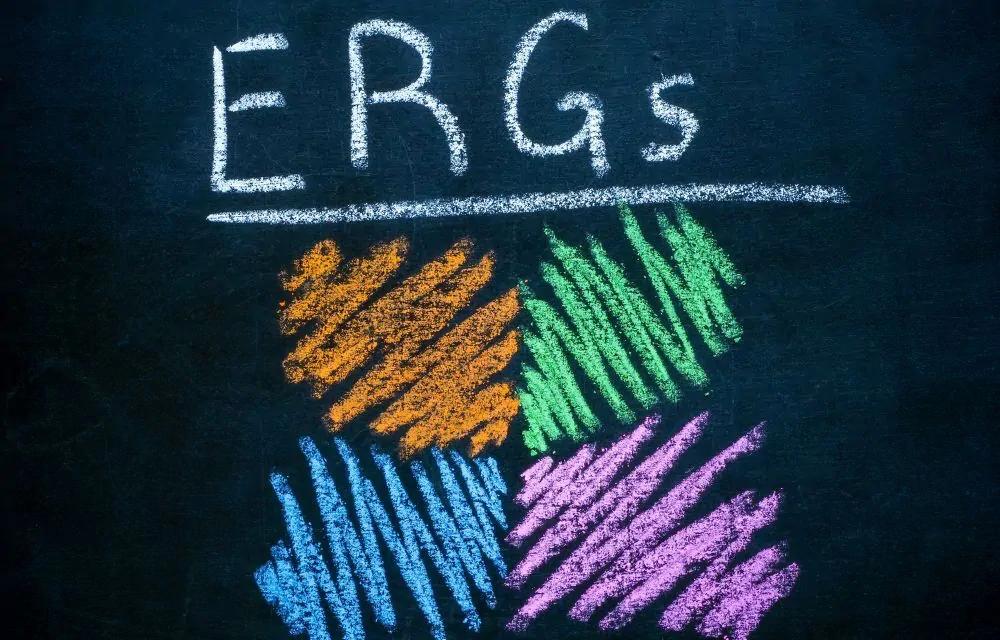If you’re interested in creating a better sense of belonging and more engagement in your workplace, forming an Employee Resource Group (ERG) can be a significant step. These groups create safe but brave spaces where like-minded people can build a culture of inclusion within their company.
In this article, we’ll delve into the history of these groups and discuss how you can share the business advantages — including recruitment and retention and fostering diversity, inclusion, and employee engagement — with leadership. Finally, we’ll discuss how to plan your first meeting and the challenges and solutions many ERGs face.
What are Employee Resource Groups?
ERGs are voluntary, employee-led groups dedicated to creating a more diverse and inclusive workplace. These groups are often formed around a common interest, background, or demographic, such as gender, race, sexual orientation, or disability. They provide a platform for employees to connect, share experiences, and support one another.
These groups can enhance employee engagement, improve retention rates, and foster a more inclusive workplace culture, making each member feel connected and valued. In addition, your ERG should be aligned with your organization’s mission, values, goals, business practices, and objectives.
What’s the History of ERGs?
ERGs are not a new concept. They originated in the late 1960s and early 1970s as a way for Black employees to come together and discuss race-based tensions in the workforce. Understanding this historical context can provide a deeper appreciation for the role of ERGs in fostering diversity and inclusion.
The first known ERG was the National Black Employee Caucus at Xerox, which was started in 1970 with the support of CEO Joseph Wilson. After the 1964 race riots in Rochester, New York – where Xerox was headquartered – Wilson wanted to know how the company could better support its Black workforce. The caucus created a space for them to share their experiences and advocate for inclusivity and positive change within the company.
Learning that there was strength in numbers, regional Black caucus groups of Xerox employees created a national organization in 1974. Now known as the National Black Employees Association, this organization continues to create an internal pipeline of promotable Black candidates across all disciplines within Xerox. It also works to champion clear career paths and to identify training gaps.
The 4 C’s of ERGs
ERGs are often built on four fundamental pillars known as the 4 C’s:
- Community: ERGs foster community among employees with similar backgrounds or interests. They provide emotional support, build friendships, and establish a network of allies within the organization, which may notably improve morale and job satisfaction.
- Camaraderie: These groups bring together employees who might not otherwise interact, which may lead to more vital teamwork, collaboration, and mutual respect between colleagues from diverse backgrounds.
- Career Development: ERGs often focus on the professional development of their members. This can include mentoring programs, leadership training, skill-building workshops, and networking opportunities.
- Cultural Awareness: ERGs are crucial in promoting DEI and increased understanding within the workplace. They can organize events, training sessions, and discussions that educate employees about different cultures, perspectives, and experiences. This increased cultural awareness may help reduce biases and encourage a more inclusive work environment.

The Business Impact of ERG Success
Here are some reasons why ERGs are beneficial not only for employees but may also be beneficial for your organization. Consider sharing these facts with senior leadership, as they may help them better see the value of your efforts.
Remaining competitive in the business landscape: Companies must continue to keep pace with industry trends and best practices. McKinsey reports that 90% of Fortune 500 companies have ERGs. By establishing and supporting one of the groups, your company can stay competitive and demonstrate its commitment to diversity and inclusion.
Enhanced reputation: Companies that actively support ERGs often enjoy a reputation as employers of choice. A recent article inhttps://www.forbes.com/sites/kalinabryant/2023/09/15/the-impact-of-employee-resource-groups-in-the-workforce/Forbes stated that ERGs positively impact a company’s reputation by showing that it values and supports its employees. ERGs provide valuable leadership development and mentoring opportunities, discover diversity champions, and enhance the organization’s standing within the community.
Diverse perspectives for branding: ERGs bring diverse perspectives, which can be invaluable for branding and marketing efforts. Through incorporating insights and knowledge from employees with different backgrounds and experiences, companies can create more inclusive and appealing products, services, and marketing campaigns. This diversity of thought can improve innovation, creativity, and product development.
Talent attraction and retention: ERGs can be a powerful tool for attracting and retaining talent. Employees are more likely to stay with a company where they feel valued, supported, and included. By providing a platform for them to connect, grow, and contribute, ERGs can enhance employee satisfaction and loyalty. According toMcKinsey, helping employees find purpose through ERGs can significantly improve retention rates.
It’s also essential to consider the potential risks of not having an ERG, such as decreased employee engagement, higher turnover rates, and a less diverse and inclusive workplace.
Without an ERG, employees may feel less connected, leading to lower engagement and potentially higher turnover. A lack of diversity and inclusion initiatives can also negatively impact the company’s reputation and ability to attract top talent.

How to Start an ERG
Starting an ERG can seem daunting, but with careful planning and strategic execution, it can succeed. Here are some steps to guide you through the process:
- Identify the type of ERG you want to form: Consider your colleagues’ needs and interests and the gaps an ERG could fill. Observe employees within the specific niche you are targeting and gauge their interest and willingness to participate. Your ERG could be in a particular demographic or background, for example, or serve the needs of the LGBTQ community or women in a highly male-dominated industry.
- Speak with upper management: Having management’s backing can provide credibility and resources for your ERG. Start by explaining the benefits of an ERG and how it aligns with the company’s goals and values.
- Seek upper management’s assistance in spreading the word within your organization. An email from the CEO introducing your ERG or accessing the company’s internal PR will prove invaluable.
- Find an executive sponsor(s) for your ERG. Getting a senior leader invested helps your group gain momentum more quickly. Your executive sponsor can take your group’s concerns to their fellow executives.
- Identify reputable coworkers to lead: These individuals should be passionate about the ERG’s mission and capable of providing leadership and direction. Appointing leads beforehand can help establish order and structure for the first meeting. Additionally, consider implementing term lengths for leads and allowing ERG members to vote on new leads after each term.
- Market the initial meeting: Promote the initial ERG meeting to build interest and ensure good attendance. Use multiple tactics to market the meeting, such as email announcements, posters, internal extranet, and word-of-mouth. Be consistent in your efforts to keep the momentum going. Creating a buzz around the first meeting can set a positive tone for future engagements.
What are the processes for a successful ERG meeting?
Effective meetings are crucial for maintaining engagement and achieving the group’s goals. Here are some best practices:
First meeting
Your first meeting should be focused on laying the foundation for the ERG. Key points to cover include:
- Introductions: Allow members to introduce themselves and share their reasons for joining the ERG.
- Purpose for creation: Clearly articulate the purpose and objectives of the ERG.
- Member expectations: Discuss what members want from the ERG and how they can contribute.
Establishing policies
During the first meeting, all members will be involved in deciding key ERG policies. This democratic approach allows everyone to have a voice and feel invested in the group’s success. Establish the following policies early:
- Mission statement: Create a charter that reflects the ERG’s goals and values.
- Bylaws: Develop bylaws that outline the structure, roles, and responsibilities.
- Leadership positions: Discuss the process for appointing and electing ERG leaders.
- Clear objectives: By deciding on key performance indicators (KPIs), you’ll be better able to measure your group’s impact and effectiveness. Plus, having KPIs will make it simpler to demonstrate the value of your ERG. Consider regularly evaluating and sharing with the C-suite how far you have progressed toward your goals.
After the first meeting: Building consistency
Regular meetings are essential for maintaining momentum and achieving your group’s objectives. Aim to meet a maximum of once a month but at least once every other month. Critical activities for regular meetings include:
- Company culture updates: Provide updates on company culture and any relevant initiatives.
- Workplace issues: Discuss any issues or challenges seen within the workplace and brainstorm solutions.
- Open forum: Remember to allow everyone to share their experiences freely.
Challenges and solutions of Employee Resource Groups
Starting and maintaining an ERG comes with several challenges. Being prepared to handle potential crises is crucial for the longevity and success of your group. While every ERG will face unique issues, here are some common challenges and suggested solutions to get past them:
Challenge: Lack of funding
Solution: To address this, identify the person in your group with the most ties to upper-level management.McKinsey Research believes ERG leaders with solid and executive relations excel at obtaining resources and funding. Take the time early in your ERG’s lifespan to build a strong relationship with management to support your group.
Challenge: Lack of communication
Solution: ERG members and potential members of your group need to know basic information, such as meeting times, locations, and impact reports. To overcome this, utilize one platform as a centralized “home base” for all ERG information. For example, if your company uses Microsoft Teams, consider making a channel so your group can stay in touch during the busy workday.
As your group becomes more familiar with its work, capture best practices, processes, and lessons you’ve learned for future members.
Challenge: Lack of leadership support
Solution: To prevent this, establish goals and values for your ERG that align with the company’s broader goals and mission. Continually share your group’s goals and the impact you are making on employee engagement, innovation, and retention.
In conclusion
McKinsey reports that 90 percent of Fortune 500 companies have ERGs. The most successful go beyond simple DEI to create a transformative infrastructure that ensures authentic inclusion, growth, and impact. In addition, employees who see their ERG as effective are significantly more likely to report positive inclusion scores than employees who consider their group ineffective.
These statistics underscore the need for a clear purpose, strategic alignment with company goals, and detailed communication on all levels. These elements are not just desirable, but essential for the success of your ERG. Your members need to feel more than a sense of belonging. They must also gain support, better career advancement, and increased access to senior leadership.
Money and benefits are just one aspect of career success today. Employees are increasingly seeking to align their careers with their life’s purpose. They want to be heard and, just as importantly, they want to have a voice. When effectively led, your ERG can be a dynamic, authentic, and inspiring part of their journey, helping them find fulfillment in their work.
Once your group gains momentum, you should seek development programs, workshops, training sessions, or seminars related to your group’s focus area. These initiatives are not just about acquiring new skills and knowledge, but also about renewing members’ motivation and keeping them engaged in their work and the group’s mission.
EWF designs impactful, career-focused sessions that foster supportive environments and drive positive promotion rates for diverse employees. From lunch and learn sessions to workshops and development days, we understand the importance of delivering engaging and impactful content that drives the desired change within your organization.
Learn more on our website: https://ewfinternational.com/programming-for-employee-resource-groups/




